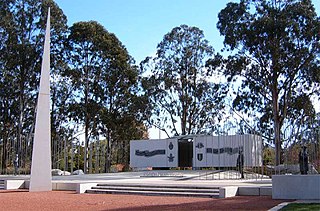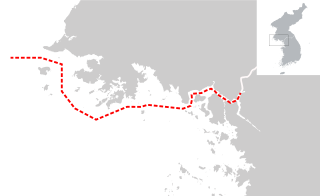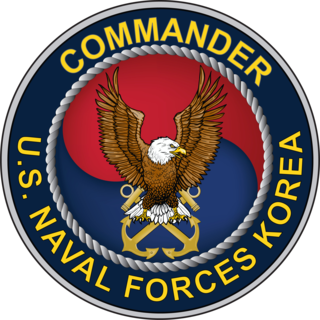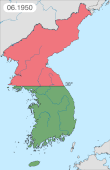Related Research Articles

The Korean War was fought between North Korea and South Korea from 1950 to 1953. The war began on 25 June 1950 when North Korea invaded South Korea. The war ceased with an armistice on 27 July 1953. North Korea was supported by China and the Soviet Union while South Korea was supported by the United States and the United Nations (UN).

The Korean People's Army is the military force of North Korea and the armed wing of the Workers' Party of Korea (WPK). The KPA consists of five branches: the Ground Force, the Naval Force, the Air Force, Strategic Force, and the Special Operation Force. It is commanded by the WPK Central Military Commission, which is chaired by the WPK general secretary, and the president of the State Affairs; both posts are currently headed by Kim Jong Un.

Panmunjom, also known as Panmunjeom, now located in Paju, Gyeonggi Province, South Korea or Panmun-guyok, Kaesong, North Korea, was a village just north of the de facto border between North and South Korea, where the 1953 Korean Armistice Agreement that ended the Korean War was signed. The building where the armistice was signed still stands.

A ceasefire, also spelled cease fire, is a temporary stoppage of a war in which each side agrees with the other to suspend aggressive actions. Ceasefires may be between state actors or involve non-state actors.

The history of the United Nations as an international organization has its origins in World War II beginning with the Declaration of St James's Palace. Taking up the Wilsonian mantle in 1944-1945, US President Franklin D. Roosevelt pushed as his highest postwar priority the establishment of the United Nations to replace the defunct League of Nations. Roosevelt planned that it would be controlled by the United States, Soviet Union, United Kingdom and China. He expected this Big Four would resolve all major world problems at the powerful Security Council. However the UN was largely paralyzed by the veto of the Soviet Union when dealing with Cold War issues from 1947 to 1989. Since then its aims and activities have expanded to make it the archetypal international body in the early 21st century.

The Australian National Korean War Memorial is on Anzac Parade, the principal ceremonial and memorial avenue in Canberra, the national capital city of Australia.

The Northern Limit Line or North Limit Line (NLL) – 북방한계선 – is a disputed maritime demarcation line in the Yellow (West) Sea between the Democratic People's Republic of Korea (DPRK) in the north, and the Republic of Korea (ROK) in the south. This line of military control acts as the de facto maritime boundary between North and South Korea.

United Nations Command is the multinational military force established to support the Republic of Korea during and after the Korean War. It was the first international unified command in history, and the first attempt at collective security pursuant to the Charter of the United Nations.

The U.S. Naval Forces Korea is a major shore command of the United States Navy that serves as the shore support agency for all U.S. naval activity in South Korea. Known by the initials "CNFK", an abbreviation of the address format of the unit, its headquarters are at Busan Naval Base, Busan.

The Neutral Nations Supervisory Commission (NNSC) was established by the Korean Armistice Agreement signed 27 July 1953, declaring an armistice in the Korean War. It is, with the Military Armistice Commission, part of the mechanism regulating the relations between the Democratic People's Republic of Korea and the Republic of Korea.
Australia was one of the founding members of the United Nations (UN) in 1945 and has been actively engaged in the organisation since its formation. The UN is seen by the Australian Government as a means to influence events which directly affect Australia's interests but over which they have little unilateral control.

United Nations Security Council Resolution 83, adopted on June 27, 1950, determined that the attack on the Republic of Korea by forces from North Korea constituted a breach of the peace. The Council called for an immediate cessation of hostilities and for the authorities in North Korea to withdraw their armed forces to the 38th parallel. They also noted the report by the United Nations Commission on Korea that stated North Korea's failure to comply with Security Council Resolution 82 and that urgent military measures were required to restore international peace and security.

The United Nations Commission on Korea was established on 12 December 1948 by the United Nations (UN) to deal with various issues relating to the trusteeship of Korea. It was eventually dissolved on 7 October 1950.

The United Nations Command Military Armistice Commission (UNCMAC) was established in July 1953 at the end of the Korean War. The mission of UNCMAC is to supervise the Military Armistice Agreement between the two Korea's along the 151 mile Demilitarized Zone (DMZ). UNCMAC is headquartered in Seoul and Panmunjom.

The Special Operations Command Korea or SOCKOR, the United States (U.S.) Theater Special Operations Command (TSOC) in the Republic of Korea (ROK), is a Sub-Unified Command assigned under the Combatant Command (CCMD) of United States Special Operations Command (USSOCOM), who delegated Operational Command (OPCON) of SOCKOR to the U.S. Indo-Pacific Command (USINDOPACOM) Commander, who further delegated OPCON of SOCKOR to the United States Forces Korea (USFK) Commander.

The Korean Armistice Agreement is an armistice that brought about a complete cessation of hostilities of the Korean War. It was signed by United States Army Lieutenant General William Harrison Jr. and General Mark W. Clark representing the United Nations Command (UNC), North Korea leader Kim Il Sung and General Nam Il representing the Korean People's Army (KPA), and Peng Dehuai representing the Chinese People's Volunteer Army (PVA). The armistice was signed on 27 July 1953, and was designed to "ensure a complete cessation of hostilities and of all acts of armed force in Korea until a final peaceful settlement is achieved."

The Kingdom of Thailand was one of the 21 countries who responded to the United Nations request to send troops to aid South Korea during the Korean War 1950–1953. As well as being one of the first countries to openly express its support for South Korea's cause, whilst also being one of the UN's larger contributors to the war. Thai support was important to battles determining the outcome of the war, such as the Third Battle of Seoul.

The United Nations Memorial Cemetery in Korea, located at Tanggok in the Nam District, City of Busan, Republic of Korea, is a burial ground for United Nations Command (UNC) casualties of the Korean War. It contains 2,300 graves and is the only United Nations cemetery in the world. Laid out over 14 hectares, the graves are set out in 22 sites designated by the nationalities of the buried servicemembers.
Events from the year 1953 in North Korea.

United Nations Command–Rear is a rump military command headquartered in Japan, and a subordinate element of United Nations Command. UN Command–Rear was established in 1957 as a result of the relocation of UN Command from Japan to South Korea following the Korean War. It is nominally in control of the rear elements of what the United States and South Korea contend are United Nations military forces in northeast Asia.
